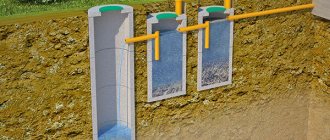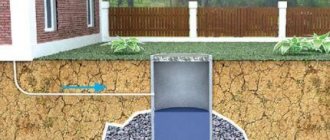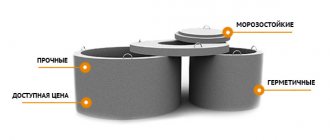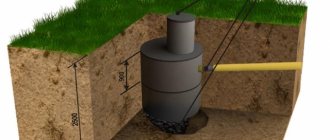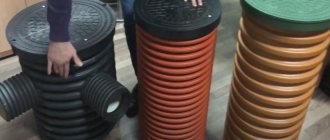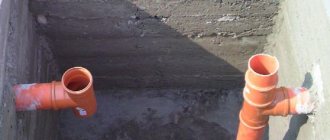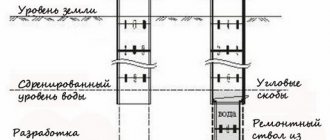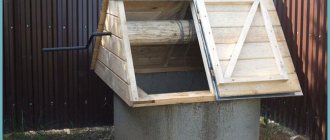It is best to start building a country house with the installation of a sewer system. Agree, correctly designing and organizing wastewater drainage on a site is not an easy task. We will have to think carefully about solving this problem. After all, improper installation of sewerage threatens to make life in the house unbearable.
We will tell you how to create a functional septic tank on your site yourself. Thus, among the affordable materials used in the construction of local treatment facilities, the most popular today are concrete rings.
We will talk about how to build septic tanks from rings with your own hands, and what to consider during the installation process. In addition, in the article you will find videos with advice from experienced specialists, detailed instructions for installing a septic tank, as well as many useful recommendations about installing a sewer system in a country house.
Advantages and disadvantages of septic tanks made from rings
In a homemade septic tank made of concrete rings, they are one of the main elements of the sewer system being installed. These products are characterized by high performance characteristics.
Tanks built from them, due to the technical advantages of reinforced concrete products, have high strength and excellent resistance to the influence of aggressive substances.
Among the advantages of septic tanks made of concrete rings, it should be noted:
- Affordable price
. Since this construction product has a low cost, many owners of country real estate, even those with limited financial resources, can afford to build a reservoir from it. - Durability and strength
. Concrete has superior strength parameters to brick and is not inferior to materials such as natural stone. It can withstand high pressure and is not dangerous from volumetric salvo discharges. The service life of do-it-yourself septic tanks made from rings can reach more than 50 years. - Tank tightness
. Thanks to high-quality waterproofing, the structure made of concrete rings is resistant to groundwater from the outside and completely sealed from the inside. - Capacity
. Such containers are capable of collecting a large volume of wastewater, so their cleaning procedure can be performed once over several years.
If you build a septic tank from rings, reinforced concrete products will cost less than polypropylene containers.
But this design also has disadvantages, which include:
- Heavy weight. Before making a septic tank from concrete rings, you will need to order special equipment to move these heavy elements.
- There is a possibility of waste liquid penetrating into the underlying soil layers. This problem can arise during the operation of the septic tank as a result of cracks in the concrete or due to depressurization of the seams, which leads to the loss of its protective functions.
Before building a septic tank from concrete rings, it is advisable to analyze all the pros and cons of this building material. You should also evaluate your own capabilities regarding the use of special equipment.
Sewer maintenance
There are several simple rules, the implementation of which will extend the life of the septic tank:
- clean tanks of waste as they fill;
- clean pipelines every 6 months;
- Once every 5 years, clean the bottom of heavy fats. It can be done more often, especially if silt sediments occupy more than 25% of the total volume. During the purification process, part of the sludge must be left for the natural restoration of microflora;
- periodically carry out laboratory analysis of wastewater to determine the level of acidity - this will allow you to determine the level of water purification.
Options for creating a structure
Installing a septic tank from reinforced concrete products is not considered too difficult a job. It may have a two- or three-chamber design. Regardless of the type of design, in the process of servicing it, you need to seek the services of vacuum cleaners and order special equipment to remove solid waste that collects on the internal surfaces of the tank.
A single-chamber septic tank made of rings is a storage tank that operates on the principle of a cesspool; it is equipped much less frequently. Property owners give preference to these designs when it is necessary to equip a sewer system for small-sized country houses in which the owners live in the summer or during vacation, provided that the volume of wastewater is insignificant.
Another important reason for choosing a single-chamber storage tank is the high level of groundwater, as well as the predominance of clayey rocks in the geology of the territory.
A septic tank with two wells or three chambers is installed when creating autonomous treatment facilities for country houses, which are intended for permanent residence, when the planned volume of waste liquid is large.
In the process of arranging a two-chamber structure, if it is supplemented with a filtration field or a filter well, the first chamber is a sealed container with a limited amount of oxygen. It must be equipped with a concrete or cast iron hatch, a supply and drainage line. The second compartment is equipped with a ventilation pipe to ensure oxygen access.
In a sewerage scheme made of concrete rings, consisting of two or three tanks, wastewater is subjected to multi-stage treatment by settling and filtration:
- In the first storage tank, a pre-cleaning process occurs, during which large suspensions settle and, in conditions of lack of oxygen, undergo decomposition, and anaerobic bacteria process organic matter. In the second tank, the purification and filtration process continues, but aerobic bacteria and oxygen are already involved.
- Decomposed organic residues, which look like sludge, sink to the bottom, and clarified waste flows into a drainage well, which is also called a filter or absorption well.
From there, through holes in the walls, the purified water is filtered through a sand-crushed stone layer and sent into the soil. When a personal plot is located on soils that have sufficient filtration properties and are well absorbent and permeable to liquid, and the level of groundwater is low, it is better to give preference to the option of installing a septic tank, in which the clarified liquid is redirected to the absorption compartment.
On soil with a depth of underground water layers reaching only 2.5 meters, the cleaning process becomes impossible, since there must be at least one meter between the lowest point of the drainage well for a septic tank made of concrete rings and groundwater.
In this situation, it would be better to drain the treated wastewater to drainage fields. But the arrangement of such systems requires a large area of land.
Start of operation
The operation of a septic tank is impossible without a large number of anaerobic microorganisms. The accumulation of such microflora naturally takes almost half a year. To shorten this time period, the septic tank is saturated with additional microflora. They do this in 2 ways:
- You need to fill the septic tank with sewage for 2 weeks, then add sludge from another working septic tank to it in a ratio of 2 buckets per 1 cubic meter.
- Add ready-made biological products (strains of anaerobic bacteria), sold in specialized stores or online sites.
Selecting a location for a treatment plant
When designing a septic tank, the sanitary zone is placed so that organic waste cannot penetrate into the fertile soil and source of drinking water. For this reason, you need to adhere to the relevant building codes regulating how to properly make a septic tank from rings or other building materials.
The wastewater treatment system in a suburban area is equipped taking into account the following provisions:
- SNiPa 2.04.03.85 - it reflects the rules for the construction of external sewerage facilities;
- SanPiN 2.2.1/2.1.1.1200-03 - this document lists the requirements that should be met when creating zones considered environmentally unsafe.
According to these standards, to prevent the foundation of the house from getting wet due to emergency leaks, the septic tank must be placed so that it is lower than the residential building.
When choosing a location, be sure to take into account the presence of natural reservoirs with running water. The distance to them that must be maintained cannot be less than 5 meters. In this case, the gap to the trees should be 3 meters, and to the bushes - about a meter. The distance of the septic tank from the house is also important, which is better to increase, but not decrease.
It is also necessary to find out where the gas pipeline runs under the surface of the earth. It is necessary that the distance to it be at least 5 meters. But it should be borne in mind that it is prohibited to place vehicles above the place where the treatment structure is planned to be buried, since their weight can destroy the entire structure.
We install concrete rings and seal the seams
Installation of concrete rings begins with the installation of the primary base, which has a bottom. This is a ring with a bottom. Sometimes the bottom is sold separately and is first mounted on a prepared sand bed. If you do not have a ready-made base, there is no ring with a bottom, then it can be filled with M200 concrete. For strength, it is recommended to make reinforcement using reinforcement with a diameter of 8-12 cm. In the case of the bottom, there is no need to make it ideal for the diameter of the ring. Make it larger and it will be easier to place wastewater storage tanks during installation.
It should be taken into account. The disadvantages of concreting include time intervals that require waiting at least 1 week before installing well rings. In fact, SNiP standards tell us about 28 days, since it is during this time that concrete gains maximum design strength. But, since we don’t have time to wait that long and we won’t load the base with much weight, we can start working in just one week.
To install well rings, we recommend using the help of friends, since it is convenient when 2 people work. One takes the ring, the other is on the manipulator and helps the crane operator work with the slings. Even before installation, we recommend diluting the solution using a plasticizer so that the sand-cement mixture does not settle.
It is recommended to use non-toxic solutions to seal joints inside and outside. Therefore, it is much easier and more correct to use a regular sand-cement mortar, since it will not destroy anaerobic bacteria, which will be actively used in wastewater treatment. The solution is laid out on the prepared base, then the first well ring is lowered. It is very important to install it perfectly level so that the side edges of the ring strictly maintain the vertical.
Having installed the first ring, a solution is laid at the site of the future joint. Then, the second and subsequent rings are installed and their joints are sealed immediately. As soon as the well cover is installed, do not rush to install the hatch. First you need to fill in the side parts. The first layer will be pebbles. It will help in cleansing by passing water through itself and allowing it to be better absorbed into the ground. Therefore, before filling in the pebbles, you need to go down to the bottom of the 2nd tank, make as many through holes as possible, then you can start filling.
The base of the first tank should not be touched, as it must be perfectly sealed. Large residues will settle at the bottom, which are susceptible to decomposition by organic bacteria.
Let's not forget. Having filled in the pebbles, they are compacted, after which they begin to fill in the soil. Approximately, at a distance of about a meter from the surface of the earth, the soil stops filling up, everything is watered with water, compacted and only then the surface of the septic tank is insulated. This must be done because there is a possibility of water freezing, which may lead to a lack of overflow between tanks.
How to make a septic tank
To set up a strong and durable cleaning system in a private home, you need to have information regarding the basic rules of this process:
- The distance between the septic tank rings and the wells should be no less than half a meter. In this case, the gap filled with bitumen will act as a buffer in the event of ground movement.
- The presence of a gravel-sand or crushed stone cushion is mandatory. Thanks to this layer, the septic tank does not move, even if the soil under the tanks is unstable. The cushion is also necessary to drain liquid if the well is leaking.
- The creation of waterproofing should not be neglected. In order to construct a proper septic tank from concrete rings, the seams between adjacent products need to be sealed, for which several different types of insulating materials are used, which are used to treat the inner surface of the chambers and their outer walls.
If you adhere to the technology of how to properly make a septic tank from concrete rings, and carefully observe all installation conditions, then you will not often have to invite specialists to clean and repair the storage tank.
Technology for installing a treatment structure made of concrete rings
Work on arranging a durable and reliable septic tank from rings is not a complex undertaking. You can do them yourself. If the arrangement of several chambers is designed, a linear principle is used, in which concrete columns assembled from rings are placed along one line.
After the receiving compartment on the septic tank overflow diagram from the rings there are tanks installed in close proximity to each other. A filter column is installed at a considerable distance from them.
The step-by-step work to create a treatment facility on a personal plot is as follows:
- Carrying out measurements and design.
- Preparation and acquisition of necessary materials.
- Digging a pit and creating a cushion.
- Installation of concrete rings and insulation of seams.
- Installation of overflow pipes.
Taking measurements and designing
To ensure effective wastewater treatment, it is necessary to create conditions under which they can remain inside the storage tank for three days. For this reason, the volume of a septic tank made of concrete rings is determined taking into account the total three-day volume of wastewater.
Water consumption in accordance with daily consumption standards for one family member when using household appliances is about 200 liters. By simple calculation it can be determined that for a family consisting of 2 - 3 people, the minimum volume of a treatment plant should be approximately 2 cubic meters.
But for a cottage where 5 - 6 household members permanently live, the construction of a structure capable of accommodating 3 - 4 cubic meters is required. When determining the volume of a septic tank, experts advise making a small reserve, since if strangers arrive, there is a risk that the norm will be exceeded. To eliminate the consequences of incorrect calculations, significant financial costs will be incurred.
When deciding which rings to make a septic tank from, and how many of them are required, you need to take into account that the actual volume must exceed the calculated values. This is because as the tank fills, the wastewater rises to the location of the overflow holes - it never reaches the top edge. For this reason, the calculated volume of waste liquid should only reach the level of these pipes.
What is required to calculate the volume of a septic tank?
When thinking about installing local treatment facilities, it is necessary to decide on the design. Preference should be given to one of two modern devices - a septic tank (methane tank) or an SBR reactor (aeration tank). Most owners prefer to install digesters - equipment in which the processes of biodegradation (biocenosis) and mechanical clarification take place in an oxygen-depleted environment (anaerobic). Such equipment, being quite effective, remains affordable for the majority of owners of small private farms.
Two-chamber septic tank with filter well
First of all, it is necessary to understand that digesters are large-sized structures, the biocenosis in which occurs without forced activation (overflow, pumping, mixing), in contrast to SBR reactors, which are 6-7 times smaller with the same productivity. However, the natural processes of mechanical purification due to sedimentation (sediment formation) and flotation with fermentation gases, as well as microbiological decomposition of waste organic matter, also require the creation of certain conditions - the effectiveness of their work directly depends on the ratio of load indicators to the volume of the installation, temperature and time parameters .
Calculation of the volume of a septic tank for a private house can be carried out using a single-chamber or multi-chamber scheme. So, if the daily filling of an anaerobic installation does not exceed 1 m3, then for a full-fledged biocenosis, a single mono-capacity is quite sufficient. For large quantities of discharges, two-, less often three-chamber arrangements or modular tanks mounted in series are adopted. Two-chamber septic tanks are divided into active zones of equal size, however, division is allowed in which the first compartment occupies up to 0.75 of the total volume.
Naturally, the key importance when designing an installation is its dimensions, or rather the working (active) volume of the septic tank, which is calculated:
- as the volume of daily wastewater inflows multiplied by the number of days required for the processes of anaerobic decomposition and sedimentation to occur;
- as the total volume of all active parts of cameras or modules;
- taking into account the height of the distance from the bottom of the container (compartment) to the cut of the spout pipe from the installation;
- with deduction of the height of the layer of sedimentary accumulations (-20%). When removing sediment regularly (at least 2 times a year), its amount is not taken into account.
When calculating local treatment facilities for your site, you should rely on the fact that a septic tank, followed by soil post-treatment, is recommended for wastewater inflows of up to 3-5 m3/day. If the recycling volumes are planned to be higher, then preference should be given to SBR reactors or hybrid structures (digester + aeration tank).
Scheme for calculating a three-chamber septic tank with a filtration field
Let's look at how to calculate the volume of a septic tank for a home using simple tabular and formula calculations.
Preparation of required materials
It is advisable that the purchased septic tank rings have locks. Their presence helps to simplify the installation process and at the same time prevents the displacement of elements under the influence of frost heaving of the soil. Before purchasing rings, you should pay attention to the even placement of the seats. You also need to inspect the locks for integrity.
In addition, you will need:
- sewerage pipes;
- thermal insulation roll materials;
- waterproofing mixtures;
- river sand;
- fine crushed stone;
- cement mortar;
- polyurethane foam;
- container for preparing the solution;
- perforator;
- ladder;
- level;
- wide brush.
To make an overflow septic tank from concrete rings with your own hands, polypropylene or asbestos-cement pipes are laid between the wells, which are marked “for external sewerage.” The diameter of these products should be from 110 to 120 millimeters.
What options for a septic tank can you equip yourself?
Modern septic tanks, which can be purchased ready-made, are quite expensive. At the same time, the main task of any construction is to save money, but not lose quality. Therefore, as a septic tank that you can make yourself, we recommend using tanks assembled from well rings, built from ordinary red brick, or equipped from the wheels of heavy trucks.
The last option is used the least often. It is the most inexpensive, since the wheels can be delivered by truck without the need for loading and unloading, and installation can actually be done with your own hands.
Do not forget. The disadvantage of arranging a drainage pit from wheels is the complete lack of tightness. In addition, the wheels have the ability to float. Therefore, if a concrete slab is not installed on top of such a septic tank, which will press down the wheels, there is a high probability that when the hole is filled, the wheels may shift, which will lead to the bending of the sewer pipe or its deformation. Wheels usually produce a single-chamber version of a septic tank.
Another option for a septic tank is tanks built with your own hands from red ordinary brick. Here a dense concrete bottom is poured, then the walls and central partition are built. In this case, the first septic tank has a larger volume. Both tanks are connected to each other by a plastic pipe. It is necessary to lay a reinforced concrete slab on top of the containers, therefore, when determining the width, it is necessary to proceed from the dimensions of the width of the reinforced concrete product. As a rule, it is 120 or 150 cm.
Finally, the third, and most suitable, inexpensive, reliable, durable option is a septic tank made from well rings. Well rings are available in various diameters and heights, which allows you to equip stacked tanks of any depth, and, ultimately, of any volume. In order to understand how much volume your family will need, you need to use SNIP standards.
Design basis. Of these, we need to know that per person there are about 200 liters per day. Therefore, multiply 200 by the number of people permanently living in your home, triple the figure and add 15% to the resulting value. This way you can organize a drain that has a significant supply.
Having equipped an overflow between the tanks, the septic tank from the well rings will not have to be pumped out so often. The main thing is to comply with all construction standards, take into account the nuances and experience of past years.
Creation of a pit and a “pillow”
The best period for excavation work is the hot months or the first frosty days. The fact is that then the level of groundwater is at its lowest.
The pit can be dug manually by hiring a team of craftsmen or using an excavator. The costs of digging services and calling out special equipment are comparable. The dimensions of the dug pit should be larger than the dimensions of the mounted rings by approximately 50 - 80 centimeters.
This will make the installation process much easier and will allow for external waterproofing of the seams of the building elements. When calculating the depth of a septic tank made of concrete rings, take into account the height of the filtration cushion, which is 20 - 30 centimeters, the dimensions of the rings and the thickness of the slab - about 15 centimeters.
The pit for the construction of a treatment structure should be made two-tiered, with the second chamber buried 50 centimeters below the first. Another option is to dig a separate hole for each tank. To lay sewer pipes, trenches are dug and laid below the freezing level of the soil.
The parameters of the trenches are selected in accordance with the sizes of the rings used to create the chambers. They are usually made 50 centimeters wide and 120 - 150 centimeters deep. The bottom of the dug trenches is placed at a slight slope of 2–3 centimeters per linear meter. It is better to first measure the distance between the two extreme points and multiply it by the slope in accordance with the norm.
If this condition is met, gravity flow of wastewater will be ensured. The bottom of the finished trenches is leveled and compacted, covered with sand until a layer 10 centimeters thick is formed. Then it is compacted again. To pour a concrete slab, use cement mortar. If there is a bottom in the lower ring, you do not need to make a screed.
In this case, it is enough to use a backfill of crushed stone, laying it in a 20-centimeter layer. The effect should be achieved when the pillow sag significantly. To achieve its maximum density, you need to alternate tamping with pouring crushed stone with water.
Carrying out calculations
You can calculate the required volume of tanks using the example of a family consisting of four people. On average, each of them consumes 200 liters of water per day, which is a total volume of 0.8 m³. If friends or relatives are visiting the house, the total discharge can reach 1.5 m³. When designing, an indicator equal to three daily volumes of wastewater is included. That is, it is necessary to lay a well with a capacity of 4.5-5.0 m³.
Next you need to decide on the rings. Their conditional capacity is calculated using a simple mathematical formula by multiplying the square of the internal radius by 3.14.
As a result, we obtain the following data for standard pipes 90 cm high with the following cross-section:
- 100 cm - 0.7 m³;
- 150 cm - 1.4 m³;
- 100 cm - 2.8 m³.
Thus, the need for rings only to collect liquid will be as follows:
- 100 cm - 7 pcs;
- 150 cm - 4 pcs;
- 100 cm - 2 pcs.
This is only the need for reinforced concrete products for the construction of the first tank.
Important! For its base, you should purchase a ring with a bottom. This solution, with a small overpayment, will save time on filling it yourself.
To build a filter well, you will need 1 more ring. The lower product will be used for filling crushed stone and sand. This is exactly how much of these materials are needed to ensure high-quality wastewater treatment.
Attention! if you use pipes of larger diameter, this will make excavation work easier and faster, since digging wide holes is much easier than narrow and deep ones. Wide shafts are easier and more convenient to maintain and clean. The only disadvantage of this solution is that several meters of usable space are taken away.
Installation of concrete rings and insulation of seams
The arrangement of a septic tank begins with the installation of its closed part, which is the lower ring with a bottom. It is placed so that the walls are strictly vertical. Compliance with this condition ensures the stability and strength of the entire structure.
If a bottomless ring is used as a base, the base should be concreted. For this purpose, a 30-centimeter thick concrete screed is poured at the bottom of the pit.
Its dimensions should be 20 centimeters larger than the diameter of the ring used. It usually takes up to two weeks for the concrete to completely harden. After it has acquired the required strength, proceed with the installation of the first ring. It is impossible to do this without outside help. This work will require the participation of several assistants.
To protect the treatment structure from leakage, as well as to reduce the harmful effects of underground water sources on concrete, the junction of the base with the lower edge of the ring is covered with a moisture-resistant cement mortar.
To ensure waterproofing, deep penetration impregnation or bitumen-based mastic is used. To treat concrete rings, compositions containing cement are used, for example, “Aquacement”.
To carry out internal insulation, the use of toxic compounds is unacceptable. If such a structure is used, bacteria that process wastewater and sewage will die in it. When a septic tank is installed from 4 concrete rings or another number, the following is installed on each product.
To make the structure more durable, metal brackets are attached to its outer side. Their fixation points are concreted and then covered with an insulating layer.
The rings are placed in the pit using lifting equipment. The joints between them are properly sealed. The voids formed between the outer surfaces of the tanks and the walls of the pit are filled with a mixture of soil extracted during the digging process and sand. The existing “pockets” are evenly filled by alternating the composition and filling with water.
The upper part of the structure, located above the soil freezing mark, must be insulated. The fact is that in severe frost conditions there is a possibility of an ice plug appearing inside the container. In such a situation, the efficiency and speed of cleaning slows down significantly.
It is most convenient to use pieces of expanded polystyrene as a thermal insulation material or purchase ready-made products called “shells”. In the upper part of the tanks, consisting of concrete rings, there are necks equipped with holes to create sewer hatches, which are then covered with cast iron lids.
A ventilation pipe must be placed in the second compartment of the structure, which should rise 70–80 centimeters above the ground surface.
Septic tank installation technology
There is nothing difficult in making a reliable and durable septic tank from rings. When designing several compartments, a linear construction principle is used, in which all concrete columns from rings are lined up along one line.
The receiving compartment and the following tanks are placed in close proximity to each other, and the filter column is located at a slight distance from them.
Step #1 – measurements and design
One of the prerequisites for effective wastewater treatment is to create conditions for it to remain inside the walls of the septic tank for at least three days. Therefore, the dimensions of the chambers are determined using the total three-day volume of wastewater as a basis.
According to standards, the daily volume of water consumption per household, subject to the use of household appliances, is about 200 liters.
So for a family of two or three people, the minimum volume of a treatment plant should be about two cubic meters. A family of 5-6 households will require a more spacious structure with a volume of 3-4 cubic meters.
When calculating, only the volume of the septic tank compartments is taken into account; since the filter well is not one of these, it is not taken into account (+)
But when determining the volume of the structure, it is worth making a small reserve. After all, if guests arrive, there is a risk of “overfilling” the norm. And eliminating the consequences is a rather complex and at the same time expensive procedure.
The table below will help you determine what size rings you will need and in what quantity.
Marking and dimensions of manufactured reinforced concrete rings indicating the outer/inner diameter, weight and volume
When choosing rings, keep in mind that the actual volume of the column must be clearly higher than the calculated one. This is due to the fact that as the drains fill, they rise only to the level of the overflow holes and never reach the top edge. Therefore, the calculated volume of liquid must be placed up to the level of these pipes.
Step #2 – preparing the necessary materials
When choosing rings for a septic tank, it is advisable to buy products with locks. The presence of locks not only simplifies the installation process, but also prevents their displacement under the influence of frost heaving. When purchasing products, you need to pay attention to the evenness of the seats and carefully inspect the integrity of the locks.
In addition to the rings themselves, materials and construction tools will also be required:
- sewer pipes;
- fine crushed stone;
- river sand;
- polyurethane foam;
- cement mortar;
- waterproofing compounds;
- rolled thermal insulation materials;
- building level;
- ladder;
- perforator;
- wide brush;
- container for mixing the solution.
To create overflows between wells, you will need asbestos-cement or polypropylene pipes marked “for external sewerage.”
Polypropylene pipes are famous for their strength and elasticity; their operating temperature is about 65°C
The diameter of asbestos-cement or polymer pipes used for overflow should be 110-120 mm.
Step #3 – digging a pit and arranging the bottom
It is better to carry out excavation work after the onset of the first frost or in the hottest months. During this period, the lowest groundwater level is observed.
The pit can be dug manually, by hiring a team of “diggers”, or by using the services of an excavator. If we take into account the costs of carrying out excavation work, then the costs of a team of diggers will be comparable to the amounts that will be spent on calling out special equipment.
The dimensions of the finished pit should exceed the dimensions of the installed rings by 50-80 cm. This will simplify the installation process and allow for external waterproofing of the joints of the structure.
When calculating the pit depth, three values are summed up: the height of the monolithic or filtration bed (20-30 cm) + the height of the rings (indicated in the table) + the height of the slab (15 cm).
It is better to immediately remove a large amount of soil removed from the pit from the site, using the same machine that delivered the rings
The pit for installing the treatment plant should be two-tiered: its second tank should be buried 50 cm lower than the first. Alternatively, dig your own hole for each tank.
To connect sewer pipes, trenches are dug, laying them below the freezing depth of the soil. The width and depth of the trenches are selected based on the dimensions of the rings used for the construction of the tanks. Most often they are made 50 cm wide with a depth of 1.2-1.5 m.
The bottom of the dug trenches should be located at a slope of 2-3 cm, distributed per linear meter. It is better to calculate in advance the difference between the extreme points, multiplying the distance between them by the slope value stated by the standards.
Compliance with this condition will ensure gravity flow of the liquid. The leveled and compacted bottom of the trenches is covered with sand, forming a layer 10 cm thick.
The bottom of the pit is carefully compacted again. For concreting, standard cement mortar prepared in a 3:1 ratio is used.
If you plan to install a lower ring equipped with a bottom, you don’t have to construct a concrete screed. In this case, you can limit yourself to crushed stone filling, forming a layer 20 cm thick.
The bedding created after compaction must have a flat horizontal surface, free of differences
It is necessary to achieve an effect in which the pillow sags as much as possible. To thoroughly compact the embankment and achieve maximum density, tamping is alternated with filling the fill with water.
Step #4 – installing rings and sealing seams
The construction of a septic tank begins with the installation of its closed part - the lower ring, equipped with a bottom. It is set exactly so that the walls are positioned strictly vertically. Compliance with this condition will ensure the strength and stability of the structure.
When using a ring without a bottom as a base, the bottom of the pit must first be concreted. To do this, pour a concrete screed 30 cm thick. The dimensions of the created concrete screed should be 20 cm larger than the diameter of the immersed ring.
An option for pouring the base for a three-chamber septic tank, the tanks of which are arranged not in a straight line, but in the form of a triangle
It can take up to two weeks for the concrete to harden. As soon as it acquires the necessary strength, install the first ring. Laying the rings without outside help is almost impossible. This work is performed with two or three assistants.
To protect the structure from leakage and reduce the harmful effects of groundwater on concrete, the joints between the base and the lower edge of the ring are thoroughly coated with waterproof cement mortar.
Ideal for waterproofing materials:
- bitumen mastic;
- deep penetration impregnation.
As an impregnation for treating concrete rings, it is good to use cement-based compositions such as “Penetron” or “Aquacement”.
When sealing joints, liquid glass is often added to cement mixtures, which increases the resistance of the joints to excess moisture.
Toxic compounds must not be used for internal processing. During operation, they can destroy bacteria that are responsible for the decomposition of bio-inclusions.
All subsequent ones are installed on the first ring one by one. To create a more durable fixation, metal brackets are installed on the outside of the structure. The “entry” points of the staples are concreted and covered with a layer of insulation.
Immerse the rings into the tank using a tap. The resulting joints between the elements are also carefully sealed. The voids between the outer walls of the tank and the pit are filled with a mixture of soil removed when digging the pit and sand.
The “pockets” should be filled evenly, alternating compacting the soil composition with filling with water.
Such a layer will perform a dual function: drain rain and groundwater, and also serve as a shock absorber
The upper part of the structure, located above the soil freezing level, should be insulated. In severe frosts, there is a high probability that an ice plug will form inside the tank. And this significantly reduces the speed and efficiency of cleaning.
It is convenient to use as a heat insulator:
- pieces of expanded polystyrene;
- finished shell products.
At the top of the columns, necks with holes for sewer hatches are installed. They are equipped with concrete or cast iron covers.
The second compartment of the purifier is equipped with a ventilation pipe. It should rise 70-80 cm above the ground surface.
Image gallery
Photo from
Finishing concrete ring
Method for narrowing the neck of a septic tank
Sealing the butt seams of the well
Installation of ventilation pipes
Step #5 - installation of overflow pipes
The location of the overflow pipes is determined by the level of the pipe leading from the house. Since the overflow septic tank device is designed to ensure the movement of liquid by gravity, the highest point of the sewer pipe must be located below the freezing level of the soil.
The overflow on the opposite wall of the tank should be approximately 15-20 cm below the supply point.
The overflow between the second tank and the filtration column can be done at the same level, or the same 5 cm can be maintained
To connect the sewer pipe, a hole of the appropriate size is made in the wall of the ring using a perforator. The easiest way to fix the pipe in concrete is with polyurethane foam. It will retain moisture and act as a damper pad.
The entrance of the pipe to the tank wall is carefully sealed. The inlet pipes coming from the house, as well as the overflow pipes between the chambers, are equipped with tees.
The main purpose of the tee is to direct wastewater downward in order to improve its processing and prevent crust erosion
Tees at the ends of the outlet and inlet pipelines will provide unobstructed access for clearing blockages.
To increase the resistance of pipes to the most severe frosts, it is advisable to apply a layer of insulation to them and cover the top with a protective casing.
Installation of overflow pipes
Their location depends on the level of the pipeline coming from the house. There is a certain technology for how a septic tank made of concrete rings works. Its structural design provides for the movement of wastewater by gravity. The highest point of laying the sewer pipe should be located below the freezing level of the soil.
The overflow on the opposite wall of the chamber is made approximately 15 - 20 centimeters lower than the supply point. To install a sewage disposal pipe, holes of the required size are made in the wall of the tank using a perforator. To fix a pipe in concrete, it is better to use polyurethane foam, which can retain moisture and act as a damper pad.
The entry of pipes into the wall of the ring is properly sealed. Inlet pipes coming from the house, as well as overflow pipes located between the chambers, are equipped with tees. These parts, located at the ends of the outlet and inlet pipelines, will provide unobstructed access if it is necessary to clear blockages.
In order to increase the resistance of pipes to sub-zero temperatures, it is advisable to cover them with a layer of heat insulator and place a protective casing on top.
Construction of a filtration well
Such a tank can be mounted exclusively on a soil base, which allows liquid to pass through and absorb it well. When sand, gravel-pebble or crushed stone soils are located under the conditional bottom, then the treated wastewater will freely penetrate into the soil.
At the bottom of the well, a soil filter is poured about a meter deep, and it is necessary that the backfill fractions become smaller as the height increases. First, sand is poured onto the bottom in a layer of 30–40 centimeters, and a layer of fine gravel 30–40 centimeters thick is formed on top of it. As a rule, the upper filter tier is large crushed stone or gravel, which is covered with a layer of 20–30 centimeters.
If you plan to dispose of waste liquid through the bottom and walls, then the lower ring of the drainage system is made perforated. It is installed according to the same technology as products with solid walls. Crushed stone is poured into the voids between the walls of the pit and the rings.
When creating a filtration field, perforated pipes are used. They are placed on a gravel-sand “cushion”, which ensures the penetration of treated wastewater into the soil layers located below, and the top is covered with geotextiles and then covered with earth.
Preparing a pit for tanks
In any case, the pit will be large, since both the cleaning chambers and the filter well must fit into it. The ideal option is to use special equipment, it will save time. In the absence of it or if it is impossible to rent, you can also use manual labor, but it will be longer and harder.
The area of the pit depends on the number of planned wells (2 or 3)
Untreated wastewater should not get into the ground, therefore, a concrete base should be erected at the site where the settling tanks are installed. A sand cushion 40-50 cm thick is used as drainage.
Attention! There are concrete rings that have a solid bottom. They are ideal for settling chambers and do not require additional concreting of the bottom.
Concreting the base of wells prevents the penetration of contaminated wastewater into the soil
The base of the filter well also needs additional preparation. A cushion of sand, gravel and crushed stone with a thickness of 50 cm or more is the best option.
Ways to save on construction
If it is not possible to use special equipment and order a service from a team of professionals, the following methods are used. In order not to have to dig a pit and then immerse rings in it, you can build a simpler septic tank from concrete rings. In this case, the soil is removed gradually as the ring deepens. This technology is based on the fact that it falls down due to its own weight.
The concrete bottom is poured later. It will only be located inside the ring. The big disadvantage of this method is the inability to provide heat and waterproofing of the outer surface of the structure. Since the bottom is located only inside the ring, the reliability of the structure is reduced.
There is another way - building a septic tank that looks like a triangle.
By choosing this option, you can save space for installing rings and significantly reduce the amount of earthworks. But it should be taken into account that the inspection entrance will be one for three rings of the septic tank, and all overflows will need to be arranged outside its accessibility. If you adhere to the chosen technology when installing the treatment structure and follow safety rules, it will last for several decades without the risk of elements moving or collapsing.
Which rings to choose - with or without a lock?
Concrete rings with a lock (tongue-and-ridge connection) and without it are available on the market. There is an opinion that the former provide higher water resistance and better protect the septic tank structure from lateral movement.
However, according to experts, this is not true. In practice, there is no big difference between both types of rings in terms of water permeability. If there are such significant shifts in the soil during frost heaving that, in principle, they can displace one ring relative to another (the weight of one ring with a diameter of 1 m is 600 kg), then the lock will not save. As for the convenience of centering rings with a lock during installation, this is only true for a structure of two rings. In the case of a septic tank with three or more rings, the difference is unlikely to be noticeable.
